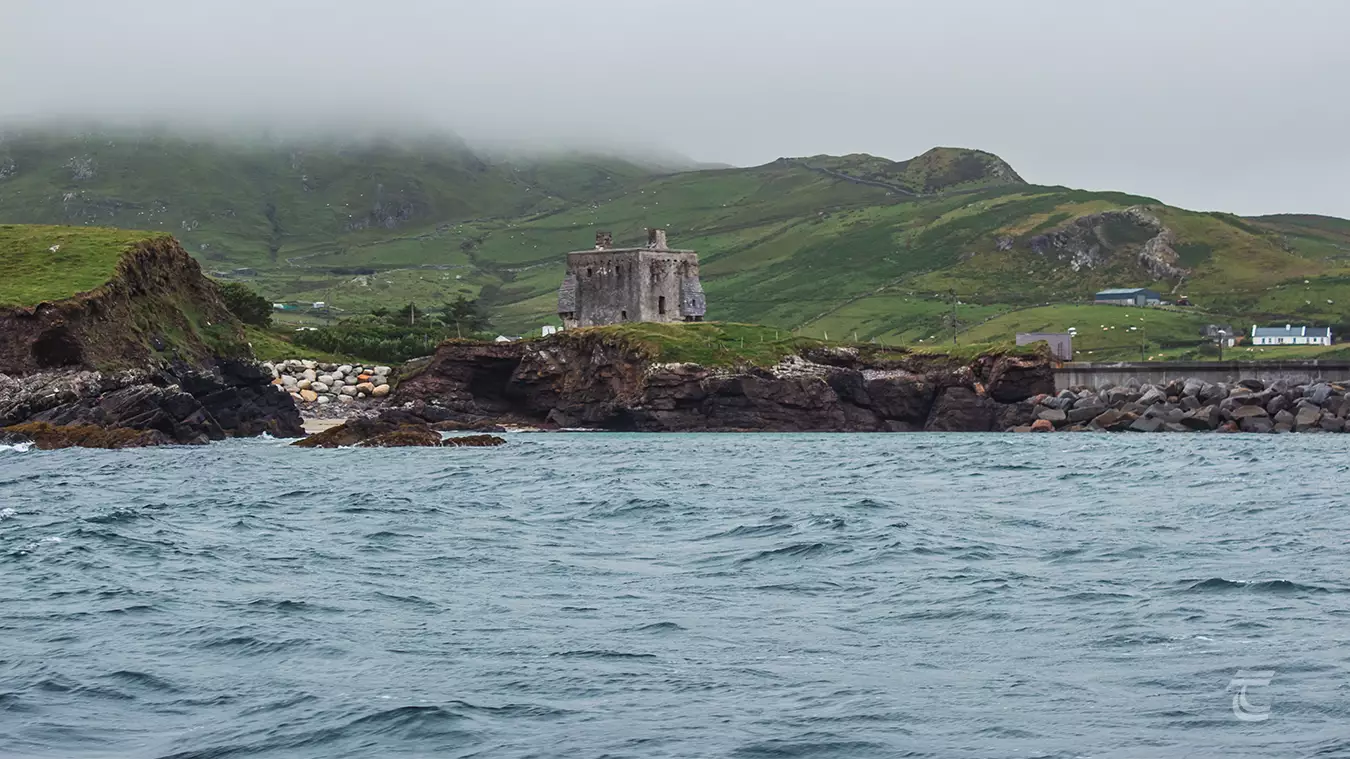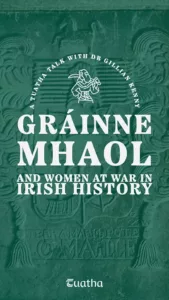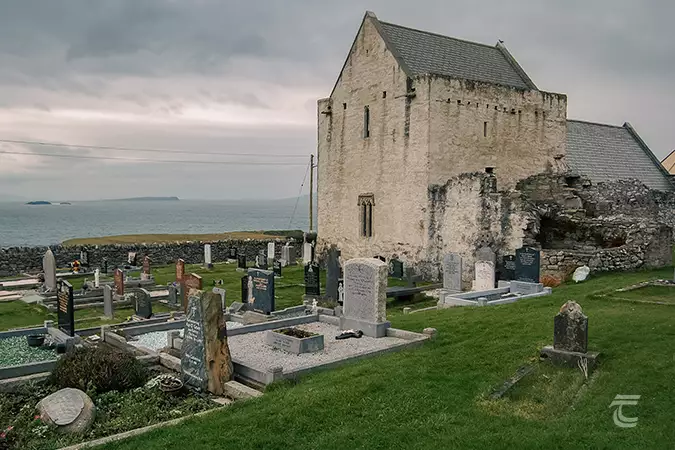Clare Island
Once home of the famous pirate queen, Gráinne Ní Mháille, Clare Island is filled with archaeology and folklore, and possesses a certain brooding beauty. The history of the island is entwined with that of the O’Malley family, who were lords of Umhall, a region that broadly encompassed the lands around Clew Bay. The earliest reference to the family comes from the Annals of the Four Masters, that recorded the slaying of ‘Donal and Murtough, two sons of Murray O’Malley…in Cliara’ in the year 1235. ‘Cliara’ was the ancient name for the island. The O’Malleys were feared and respected as a seafaring power. The most famous member of the family is of course Gráinne Ní Mháille (Grace O’ Malley), the ‘Irish Pirate Queen’ who is the subject of many stories and legends, and who is so deeply entwined with a number of fascinating monuments in this region, such as Rockfleet Castle.
Granuaile’s Castle is a towerhouse near the harbour, that is believed to have been built by the O’Malley family in the middle of the 16th century, though the exact date is uncertain due to later alterations removing most of the evidence. The earliest record of its existence occurs in a list of O’Malley castles dating from 1574. The Ordnance Survey reported in 1838 that ‘the castle remained in good repair until about the year 1750 when it was allowed to decay and remained in ruin. It was then converted into a police barracks in the 1820s, and it is labelled on the first edition of the Ordnance Survey maps as ‘Grania Wael’s Castle & Police Barracks’
The structure is rather squat looking, though it stands three storeys high. It has distinctive and decorative slate flashing on the bartizans, that was presumably added in the 19th century. The positioning of the towerhouse ensured the sheltered harbour was well protected.
For practical information about visiting this site Click Here
Once home of the famous pirate queen, Gráinne Ní Mháille, Clare Island is filled with archaeology and folklore, and possesses a certain brooding beauty. The history of the island is entwined with that of the O’Malley family, who were lords of Umhall, a region that broadly encompassed the lands around Clew Bay. The earliest reference to the family comes from the Annals of the Four Masters, that recorded the slaying of ‘Donal and Murtough, two sons of Murray O’Malley…in Cliara’ in the year 1235. ‘Cliara’ was the ancient name for the island. The O’Malleys were feared and respected as a seafaring power. The most famous member of the family is of course Gráinne Ní Mháille (Grace O’ Malley), the ‘Irish Pirate Queen’ who is the subject of many stories and legends, and who is so deeply entwined with a number of fascinating monuments in this region, such as Rockfleet Castle.
Granuaile’s Castle is a towerhouse near the harbour, that is believed to have been built by the O’Malley family in the middle of the 16th century, though the exact date is uncertain due to later alterations removing most of the evidence. The earliest record of its existence occurs in a list of O’Malley castles dating from 1574. The Ordnance Survey reported in 1838 that ‘the castle remained in good repair until about the year 1750 when it was allowed to decay and remained in ruin. It was then converted into a police barracks in the 1820s, and it is labelled on the first edition of the Ordnance Survey maps as ‘Grania Wael’s Castle & Police Barracks’
The structure is rather squat looking, though it stands three storeys high. It has distinctive and decorative slate flashing on the bartizans, that was presumably added in the 19th century. The positioning of the towerhouse ensured the sheltered harbour was well protected.
For practical information about visiting this site Click Here

Granuaile’s Castle, a medieval towerhouse on Clare Island • Mayo
Clare Island Abbey

A plaque with the coat of arms of the O MAILLE (O’Malley) family and their motto TERRA MARIQ POTENS (Powerful on Land and Sea) in Clare Island Abbey • Mayo
Clare Island Abbey is thought to have originated in the middle of the 13th century, though it is said that the community of monks were driven off the island by pirates in 1224. The powerful Cistercian foundation at Abbeyknockmoy established a small cell on Clare Island, with a handful of monks to serve the local population.
The building that we see today is a small 15th century Cistercian Church, with a small nave and a two-storey chancel, with domestic quarters for the monks above the chancel. The ceiling of the chancel is a real treasure, as it is covered with beautiful and intricate paintings which are some of the finest examples of medieval art surviving in Ireland. They depict fantastical scenes, like dragons, a cattle raid, a knight on horseback, trident wielding fishermen, wolves attacking stags and musicians. They are framed by painted rib-vaulting that perhaps echoes the grandiose architecture of Abbeyknockmoy. The paintings have recently been subject to an extensive and delicate conservation programme that has thankfully helped to preserve these remarkable scenes for the future. You can also see a crisply-carved plaque with the coat of arms of the O MAILLE (O’Malley) family and their motto TERRA MARIQ POTENS (Powerful on Land and Sea). It is next to a fine canopied tomb – said to be the tomb of the famous Pirate Queen Gráinne Mhaol herself.
The martial prowess of the O’Malleys was seen in 1588, when the Gran Grin, one of the largest ships in the Spanish Armada was driven onto rocks off Clare Island. Of the 329 men on board, only around a hundred made it to the shore where they were immediately captured by Eoghan Dowdarra Roe O’Malley (father of Granuaile). The men of Clare Island held the Spaniards captive, but when the Spanish tried to escape by stealing the islander’s boats the O’Malley’s ruthlessly slaughtered them, killing 64, including their leader Don Pedro de Mendoza.
This post may focus on the medieval monuments of the island, however, there are a number of other archaeological monuments, stunning natural heritage and walks to be enjoyed on the island. Clare Island is certainly a rewarding place to explore!

A plaque with the coat of arms of the O MAILLE (O’Malley) family and their motto TERRA MARIQ POTENS (Powerful on Land and Sea) in Clare Island Abbey • Mayo
Upper left: the chancel of Clare Island Abbey • Lower left: Clare Island Abbey • Right: beautifully preserved medieval paintings on the roof of Clare Island Abbey
Top: the chancel of Clare Island Abbey • Middle: beautifully preserved medieval paintings on the roof of Clare Island Abbey • Bottom: Clare Island Abbey
Clare Island Visitor Information
Clare Island is famous as the home of ‘Pirate Queen’ Gráinne Ní Mháille, but the island also abounds with history, heritage and stunning scenery.
Explore more sites on the Wild Atlantic Way




